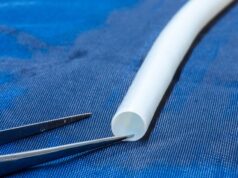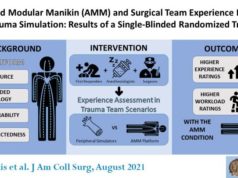 Conflict has forever been a catalyst for medical advances. In the 20th century, for example, two World Wars and innumerable smaller civil and interstate conflicts provided fertile ground for medical innovation and experimentation. To name only a few well-known advances, World War I saw the first formalised use of mass casualty triage systems, as well as rapid improvements in prosthetic limb technology and plastic surgery treatment, while World War II instigated the widespread use of penicillin and blood plasma transfusion. The Korean War led to the development of Mobile Army Surgical Hospitals (MASH) and improvements in vascular reconstruction which significantly reduced amputation rates (advances driven in part by pioneering surgeon Michael DeBakey), and the Vietnam War marked the first widespread use of helicopter ambulances in the form of “medevacs”. In the opening decades of the 21st century, the “War on Terror”, now in its fifteenth year, has spawned large and long-lasting conflicts in Afghanistan and Iraq, as well a number of smaller interventions across the Greater Middle East. Vascular News spoke to Colonel Jerry Fortuna, Director C-STARS, St Louis, USA, and faculty member at Washington University in St Louis, about what these conflicts have taught us about vascular trauma care, and how these lessons can be applied to civilian medicine.
Conflict has forever been a catalyst for medical advances. In the 20th century, for example, two World Wars and innumerable smaller civil and interstate conflicts provided fertile ground for medical innovation and experimentation. To name only a few well-known advances, World War I saw the first formalised use of mass casualty triage systems, as well as rapid improvements in prosthetic limb technology and plastic surgery treatment, while World War II instigated the widespread use of penicillin and blood plasma transfusion. The Korean War led to the development of Mobile Army Surgical Hospitals (MASH) and improvements in vascular reconstruction which significantly reduced amputation rates (advances driven in part by pioneering surgeon Michael DeBakey), and the Vietnam War marked the first widespread use of helicopter ambulances in the form of “medevacs”. In the opening decades of the 21st century, the “War on Terror”, now in its fifteenth year, has spawned large and long-lasting conflicts in Afghanistan and Iraq, as well a number of smaller interventions across the Greater Middle East. Vascular News spoke to Colonel Jerry Fortuna, Director C-STARS, St Louis, USA, and faculty member at Washington University in St Louis, about what these conflicts have taught us about vascular trauma care, and how these lessons can be applied to civilian medicine.
What does the work of the Center for Sustainment of Trauma and Readiness Skills (C-STAR) consist of?
At C-STARS, we put on 19 two-week courses each year, with the goal of getting our doctors, medics, nurses and technicians ready for wartime mission duties in-theatre. We have a lot of hospitals and clinics in the Air Force that we staff, and not all of the people there have good exposure to trauma, and sometimes even to their core skill sets. This is an opportunity for us to put them through an intensive spin-up. We go over the clinical practice guidelines and tactical combat casualty care, and help them meet their core-specifics prior to going into theatre, so everybody has their “A game” when they get there.
I am currently still an active member of the military, and I am the Site Director for C-STARS St Louis, as well as my faculty position at Washington University in the Trauma and Vascular departments.
How does the rate of vascular injury in Afghanistan and Iraq compare with previous conflicts?
The percentage of vascular injuries is higher in these two conflicts than previous ones, for a number of reasons. First, this has been driven by the type of combat body armour that the troops were wearing—today’s armour is much more protective of the torso. Second is the mechanism of injuries—we were dealing with conflicts in which significant numbers of troops were involved in blasts, including from improvised explosive devices (IEDs), in which the extremities are highly vulnerable.
I think there is also an element of improvements in survivability, and you can see this reflected in our overall “died of wounds” rates—we have the lowest died of wounds rate in conflict history. This is multifactorial. One factor is the system we put in place. Granted, it took us time, but the development of the Joint Theatre Trauma System (JTS), the development of our clinical practice guidelines, and the implementation and instruction of those guidelines through the C-STAR sites and through the JTS, really made sure that everybody was on the same page.
We also had the widespread implementation of a couple of different types of interventions. One of these is the use of tourniquets throughout the theatre, which probably saved more lives in these conflicts than anything else. We saw a real paradigm shift from how we taught trauma in the past, and we now see tourniquets creeping back into our pre-hospital care scenarios, even back in the USA. We have proven that this concept definitely saves lives.
Other advancements include damage control resuscitation with balanced blood products or the 1:1:1 concept, junctional haemorrhage control using Jett tourniquets (North American Rescue), the use of the REBOA (Resuscitative endovascular balloon occlusion of the aorta) concept and the use of trans-ischaemic acid, which was a big benefit that our British counterparts brought into theatre. Another vital advance was early utilisation of damage control resuscitation, or blood product resuscitation in the pre-hospital setting. This was another contribution from our British counterparts’ MERTs (Medical Emergency Response Teams), which we transitioned into our “vampire flights”, in which we had blood on our pre-hospital medical evacuation helicopters. All of this has resulted in a survival rate of over 98% if the patient reaches the surgeon at a role 2 medical facility.
Brian Eastridge’s paper looking at pre-hospital casualties prompted us to consider whether there were additional areas for us to improve. When we looked at our data, we found that a significant proportion of patients were still dying of haemorrhage on the battlefield, which was potentially preventable—if you can get to these people and stop the bleeding, then there is the opportunity for them to survive. As well as the tourniquets, this is where the REBOA concept came in. This gave us a way to avoid thoracotomy and deliver a system with no wire or fluoroscopy, in a contained, small-sheath system. REBOA has grown out of that, and we have gone from the traditional tools used in vascular, i.e. 12F large-sheath systems, to a 7F REBOA system. These have now been successfully implemented both in military scenarios and in civilian care in multiple countries. We know that the concept is valid. The technology has caught up, and now it is just a matter of training and implementation.
How quickly are you able to get trauma casualties to the operating room for treatment?
We still try to adhere to that very well-known time frame that we call “the golden hour”. We know that if we can get people to a surgeon within an hour of traumatic injury, mortality rates are significantly improved. We do this by layering our transportation options. We can transport people by ground or by helicopter, and we are strategic about where we put our medics and forward operating teams. This presented a little bit more of a challenge in Afghanistan due to the terrain, but it was still solvable. We had to make some adjustments and work to make sure we could accomplish this one-hour target, but it definitely made a difference in the long run.
How did your follow-up protocols evolve?
As part of our trauma system, we set up a system-wide teleconference. On a weekly basis, each echelon of care met on this teleconference, and we could go through each of the casualties that we transported individually, speaking directly to any systems issues that we had. This really constituted our “real-time” process improvement. By collecting this information and discussing it throughout the continuum of care, we were able to share, from point of injury to rehab, how these patients were doing and how we could improve care across the spectrum much faster than anything the military had utilised in the past. This is another area where we had significant improvement in affecting patients’ outcomes throughout the conflict, and this was another real success of the system.
How did trauma response differ between countries and regions?
In Afghanistan, a big difference was the amount of terrain that we were trying to cover and how isolated, at times, our forward surgical teams needed to be placed. There were times when we had to split the forward surgical teams, which stressed capabilities. Really, the issues were essentially related to time and distance.
The term that we use is “the tyranny of distance” and we can see that becoming even more prominent as we transition into other regions. For example, in Africa, we have significant time and distance challenges as we move patients. We are forced to continually push our capabilities further forward with our surgical team placements or we have to become even more innovative with our capabilities. This is the case when we look at the Pacific theatre.
The medical information we were collecting was definitely being used to help make troops safer. Tactics changed (and differed between conflicts) throughout the 14 years of war. We saw vehicle-borne IEDs in Iraq that targeted our vehicles and resulted in spinal and burn injuries inside the vehicles, so we changed vehicle designs to help deflect some of the blast and increased the armour protection. In response, the enemy adapted their tactics and used larger IEDs, so we then moved towards dismounted patrols and tried to avoid the roads. The enemy then changed from pressure-plate IEDs to more cellular-directed detonations, and we saw concomitant injury patterns change. Later in the conflict in Afghanistan, we saw that the number of amputations in our casualties was increasing from single- and double-amputees to triple- and even quadruple-amputees. Another example is the introduction of the “blast boxers” and groin protectors on body armour due to the nature of the dismounted injuries being reported. As in any kind of conflict, there was somewhat of a tactical chess game; you have to adapt to what the enemy is doing.
These are lethal combat environments, and ultimately we are in the business of the professional management of violence. In combat, we are trying to be as successful as possible in neutralising the enemy while at the same time minimising injuries and maximising survivability of our forces. As I said, our numbers were very impressive, and we were able to achieve the highest survivability and lowest died of wounds rate from any conflict in history, which is something we are all very proud of.

How important was shunting in treating battlefield casualties?
Shunting really affected how we approached distal extremity injuries. The whole idea is to restore in-line flow as quickly as possible, and this did not always necessitate definitive care with a bypass at a level 2 facility. Actually, what we found out was that if you utilised early shunting to generate an in-line flow and then direct your attention into more pressing injuries, you may find other injuries that you would have missed if you were focused on performing a lengthy bypass procedure. We made adjustments in our clinical practice guidelines to reflect that, until it became the overriding practice pattern; to shunt, to ship to the roll 3 facilities where there was a vascular surgeon, and then to perform what was hopefully definitive repair with vein bypass grafting. Doing this, we found that our limb salvage rates improved. That is really the role that shunting took in this conflict—it was really important to stop the bleeding with tourniquets and then establish faster in line flow with shunting, delaying definitive repair if necessary.
Did forward teams have access to endovascular technology? How did this affect your treatment strategies?
Early on in the war, there was very limited endovascular capability, and it took several very forward-thinking individuals to ask why this was the case. Then, it was a matter of bringing a C-arm into use for more traditional vascular surgeries (we already had them in use for orthopaedic surgery). We started off with simple things like angiograms and the coiling of solid organ injuries, as we would in any major trauma centre, and then progressed to deploying covered stent grafts in difficult junctional injury areas such as the axilla and the subclavian arteries. By the end of this period, we reached the point of being able to deploy thoracic endografts for either blunt or penetrating thoracic aortic injuries that we could cover. Some of these could be employed in a definitive manner, and some were used strictly as short- to mid-term damage control, before definitive bypass at a later date when endografts can be removed. This was not something that had really been done in previous conflicts, or at least certainly not to this extent; it really was an official adjunct to our damage control approach to some of these injuries. It allowed us to be innovative and push the envelope once we had proved that such treatments could be successful.
As we became more aggressive with interventional strategies, it paved the way for innovators to utilise technology to make devices even more practical. This was the case with REBOA. Devices moved from 12Fr systems with cumbersome wires to a 7Fr wireless system. As a result, we have just recently seen the first successful deployments of REBOA in a far forward austere surgical setting with limited support by unconventional forward surgical teams. In short, we have made significant progress not seen in any previous conflicts in regards to moving endovascular techniques to the very front lines of areas of conflict.
How difficult was it to share and develop innovations with civilian colleagues?
Innovation was easier to implement than we thought thanks to the hard work that came from so many people that were part of a joint theatre trauma system and were able to take the data, mine it, turn it into literature and then publish it for the medical community. We were learning from our successes and mistakes and sharing it with everyone willing to read and learn.
Because of the amount of data we were collecting from the trauma registries, we had the literature to support the use of new techniques. Because the conflicts lasted for so long, there were a lot of surgeons leaving the military and going into civilian jobs, where they were able to apply these techniques and put them under civilian-style protocols, and show that you can successfully implement some of these same approaches with the same outcome benefits. It is very rare that you have conflicts lasting this long, but we have seen that for every conflict we have been able to make advances in civilian medicine, and these conflicts were no different. One of the biggest contributions was Holcomb and Spinella’s haemostatic resuscitation with 1:1:1 blood product utilisation, which was huge. We have seen that permeate into doctrine for every level 1 trauma centre throughout the USA, and you can even see it in select centres showing the safety and re-demonstrating the known efficacy of whole-blood resuscitation. All of that is gaining traction in civilian communities based off what we were able to learn in the conflicts. Again, tourniquets in the pre-hospital setting is a good example– you never would have seen that 20 years ago, but it is now commonplace in the bigger centres.
We are continuing to push the envelope on everything. We are trying to develop better graft alternatives, looking at things like cellular matrix non-prosthetic grafts that we can implant into these massively contaminated fields in the hopes that they will hold up and avoid secondary infections, all of which has spurred off of ideas produced by the challenges we faced in these combat injuries.
We are in an exciting time. We will continue to mine huge amounts of data that we have collected from the joint theatre trauma system, and I think that we will continue to see insightful research and innovation into the next decade. Despite all the tragedy that has come out of these conflicts, there have also been a lot of good things and advances that will continue to push medicine for some time to come.













